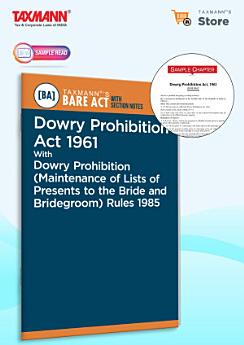Taxmann's Dowry Prohibition Act 1961 with Dowry Prohibition (Maintenance of Lists of Presents to the Bride and Bridegroom) Rules 1985 [Bare Act with Section Notes] – Annotated Legal Reference
About this ebook
This book is intended for the following audience:
• Legal Practitioners & Judiciary – Lawyers, judges, and legal advisors who need an updated reference for arguments, judgments, and legal interpretations of dowry-related provisions
• Law Students & Academics – Students pursuing law or research in social welfare and legal studies will find the legislative text, notes, and referenced case laws highly beneficial
• Social Workers & NGOs – Organisations working in the field of women's rights, domestic abuse prevention, or social reform can use this resource to ensure accurate legal guidance and advocacy
• General Readers – Families, individuals, or anyone interested in understanding the legal framework and remedies against dowry demands or related offences
The Present Publication is the 2025 Edition, covering the amended and updated text of the Dowry Prohibition Act [Act No. 28 of 1961] and Rules, with the following noteworthy features:
• [Complete Text of the Dowry Prohibition Act 1961] Includes all sections of the Act, reflecting the law as amended up to the latest date
• [Dowry Prohibition (Maintenance of Lists of Presents) Rules 1985] Presents the rules governing how lists of gifts to the bride and bridegroom must be maintained
• [Section-by-Section Notes] Invaluable insights and clarifications that interpret and simplify legal language, making each section more accessible
• [Case Law References] Selected illustrative judgments from various courts to highlight how provisions of the Act have been interpreted and applied
• [State Amendments & Variations] Summaries of how different States in India have adapted and revised the Act, enabling readers to compare jurisdictional nuances
• [Pre-amendment Provisions] Incorporates the text of provisions as they existed prior to the amendment in the respective amendment footnotes, enabling the reader to understand the legal position before the amendment and its applicability during the pre-amendment period
• [User-friendly Formatting] Bold headings, clear fonts, and structured layout help readers quickly locate relevant provisions
The structure of the book is as follows:
• Bare Act Text – The Dowry Prohibition Act, 1961 is reproduced section by section
• Section Notes – Immediately following each section, brief notes and important case law references are provided for clarity
• Rules – The Dowry Prohibition (Maintenance of Lists of Presents to the Bride and Bridegroom) Rules, 1985 are presented in a similarly annotated format
• Subject Index – Located at the end, it consolidates all topics, enabling users to navigate through various provisions efficiently
Ratings and reviews
- Flag inappropriate
About the author
At the core of Taxmann's commitment to delivering insightful and reliable information is a highly skilled Research & Editorial Team consisting of Chartered Accountants, Company Secretaries, and Lawyers. Guided by Editor-In-Chief Mr Rakesh Bhargava, this team upholds Taxmann's role as a leading content provider in the professional knowledge space.
Operating with Six Sigma-inspired precision, the team is driven to eliminate errors and maintain excellence across all content outputs. Their content creation follows strict editorial principles to ensure authority, depth, and insight. Key guidelines include:
• Verified Sourcing – All statutory content is carefully curated from credible, authorized sources, ensuring authenticity and dependability
• Up-to-Date Information – With a commitment to timely updates, the team ensures readers are informed of the latest judicial and legislative changes
• Analytical Depth – Focused on high-impact issues, the team provides deep analysis to help readers understand the implications and nuances of recent developments
• Precise and Accurate Communication – Each publication is crafted for clarity and precision, making complex topics accessible and practical for professionals
• Rigorous Referencing – Analytical insights are thoroughly referenced with relevant sections, circulars, notifications, and rulings, enhancing trustworthiness
• Consistency and Quality – Taxmann adheres strictly to standards of style, grammar, and format, ensuring a smooth and professional reading experience
• Reader-Friendly Design – Both print and digital formats are designed with legibility in mind, enhancing accessibility across platforms
By adhering to these standards, Taxmann's Editorial Team strengthens its position as a trusted content company, empowering professionals with authoritative resources to make informed decisions.








